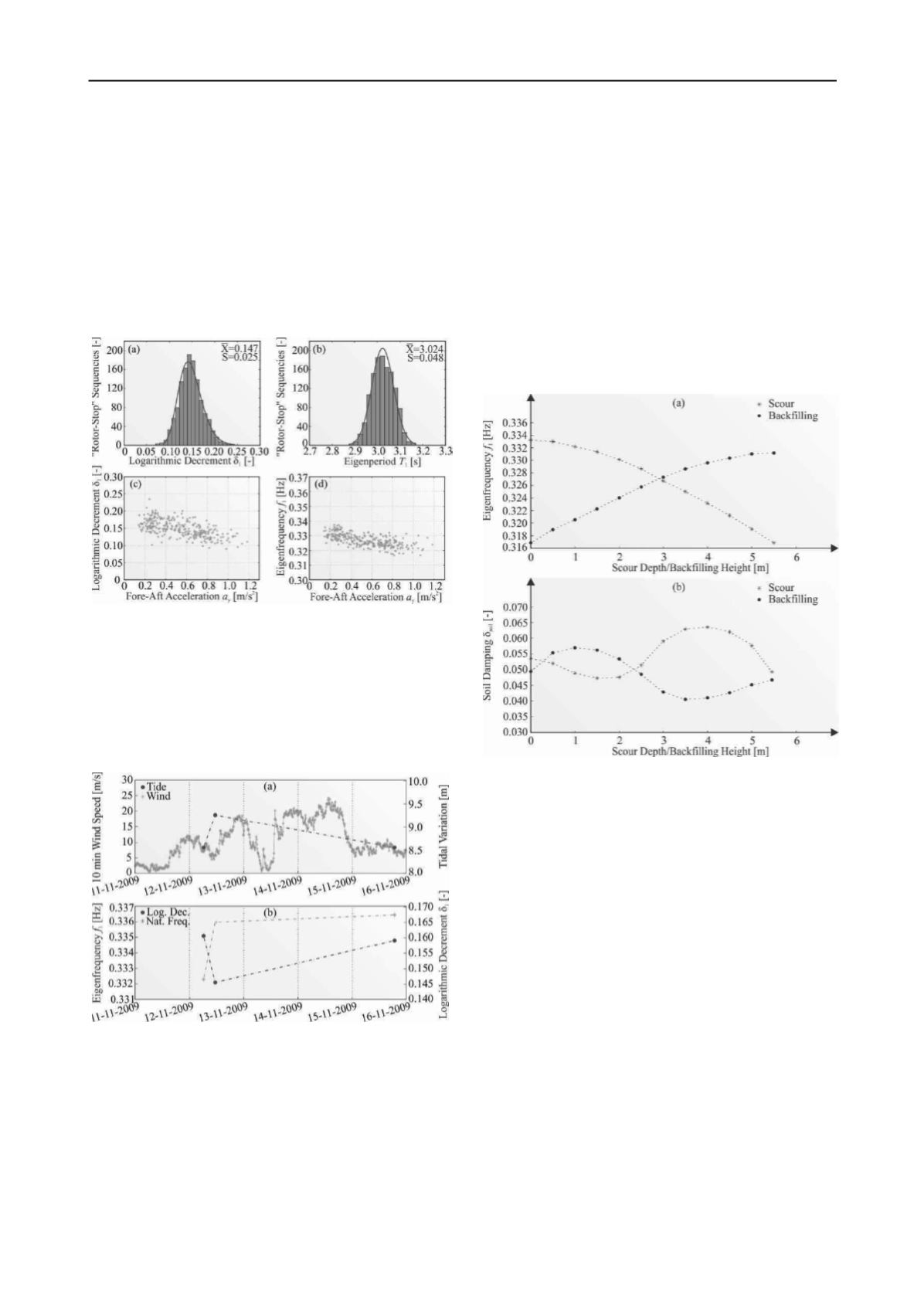
2345
Technical Committee 209 /
Comité technique 209
a tendency of decreasing modal damping and eigenfrequency is
observed for increasing acceleration level. High structural
accelerations induce irreversible soil deformations and thereby
soil damping activation. However, the oil damper performance
is characterised by optimal damping for low levels of
accelerations, which may explain the observed behaviour. In
addition, distinct non-linear soil behaviour occurs for high
accelerations, which reduces the secant stiffness
E
s
and thereby
the eigenfrequency
f
1
.
An almost identical mean value and standard deviation of
the modal parameters have been observed for each wind turbine.
Hence, the variation of the modal parameters in Figure 4c and
Figure 4d might be caused by the following conditions:
Figure 4. Free vibration tests for a total of 30 offshore wind turbines: (a)
Damping histogram, (b) Eigenperiod histogram, (c) Damping vs.
acceleration level, (d) Eigenfrequency vs. acceleration level.
Tower damper performance
Tidal variation
Wind variation
Temperature dependent modal parameters
Moveable seabed and scour around the foundation
Figure 5. Selected turbine investigation: (a) Tidal and wind variation as
a function of time, (b) Modal parameters as a function of time. Data are
collected with same acceleration level and slope of generator speed.
It has been observed that the mass pendulum of the tower
damper in some tests moves exactly with a phase identical to
the phase of the wind turbine, resulting in almost no additional
damping. To eliminate the variation of the tower damper
performance, data for each turbine is investigated for the same
slope of generator speed when the blades pitch out of the wind
and for the same acceleration level. As an example, Figure 5
shows the comparison of the measured 10-minutes wind speed
and tidal variation together with the modal parameters for a
selected turbine. One one-year measurements of the tidal levels
at the wind park show only a maximum difference between
highest and lowest astronomical tide of 2 m. It might then be
assumed that the tidal variation at the wind park has negligible
impact on the magnitude of the modal parameters. The same
conclusion can be drawn regarding the variation in the wind
speed and temperature during the tests. The aerodynamic
damping is very low, when the blades pitch out of the wind, and
a temperature change from -73° to 93° only changes the
Young’s modulus of elasticity
E
steel
with 5% (Nielsen 2004).
Based on a Winkler model this corresponds to a change in the
eigenfrequency
f
1
of only 0.5%. In conclusion, assuming that
the tower damper contributes with the same damping value in
Figure 5b, the time-dependent modal parameters might be
caused by erosion of soil particles near the monopile
foundation.
Figure 6. Scour and backfilling analysis based on a Beam on Nonlinear
Winkler Foundation model: (a) Eigenfrequency
f
1
as a function of scour
depth and backfilling height, (b) Soil damping δ
soil
as a function of scour
depth and backfilling height.
1.1
Scour and Backfilling
When a pile is installed in a loose sedimentary bed, a scour hole
will form around the pile. The phenomenon is of high
importance, since the structural eigenfrequency and soil
damping contribution will change and in worst case lead to
fatigue damage and, eventually, failure. Based on experimental
tests, Sumer
et al.
1992 stated that the mean value of the
equilibrium scour depth for a vertical cylinder in steady current
is given by 1.3
D
, where
D
is the diameter of the cylinder.
However, for combined current and wave conditions the scour
depth is difficult to determine, since wave action tends to reduce
the scour depth (Høgedal and Hald 2005).
As no scour protection is present for the investigated wind
turbine structures in this paper, the variation of the
eigenfrequency
f
1
and soil damping δ
soil
, caused by sediment
transportation at seabed, is estimated using a Winkler approach.
Different scour depths and backfill heights are considered for a
wind speed of 13 m/s with maximum depth and height equal to
1.3
D
, respectively. The vertical effective stress
p
0
is reduced
linearly with depth to a depth equal to 3
D
below the base of the
current scour hole. As expected, Figure 6a shows a decreasing
eigenfrequency
f
1
for increasing scour depth. Assuming
cohesionless backfill material with a friction angle
φ
k
of 28°,


